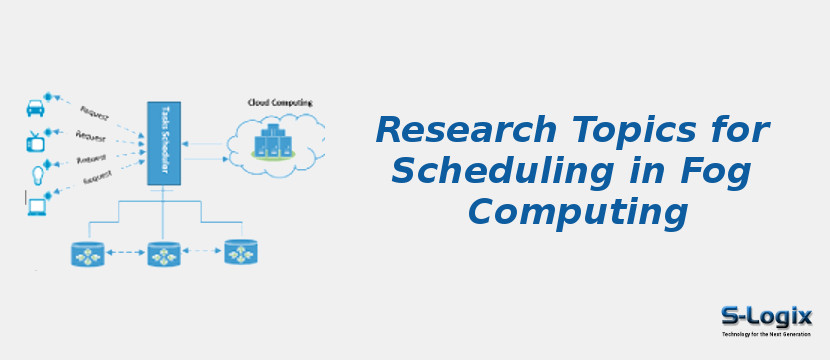Scheduling in Fog Computing infers arranging and coordinating the allocation of computing resources in a distributed environment, such as computing nodes, bandwidth, and storage.
The scheduling algorithms used in Fog Computing are designed to handle Fog Computing environments dynamic and heterogeneous nature. The scheduling algorithms also consider network congestion, node failures, and energy consumption.
The goal of scheduling in Fog Computing is to optimally allocate resources to meet the demands of various applications, balancing factors such as resource utilization, response time, and cost.
Scheduling algorithms in Fog Computing can be classified into several categories
• Centralized scheduling :
Centralized scheduling involves a single entity, such as a control node, responsible for allocating resources.
• Decentralized scheduling :
Decentralized scheduling involves multiple entities making decisions independently.
• Hybrid scheduling :
Hybrid scheduling is a combination of both centralized and decentralized scheduling.
In fog computing, various criteria are considered for scheduling a task. Some criteria are as follows,
• Task time limit
• Consumption of energy for performing a task.
• Input time
• Resource utilization: Scheduling algorithms in fog computing can optimize the use of resources such as CPU, memory, and bandwidth, leading to more efficient utilization.
• Latency reduction: Distributing tasks and data closer to the source, fog computing can reduce latency compared to cloud computing, leading to improved performance and faster response times.
• Load balancing: Scheduling algorithms in fog computing can distribute workloads dynamically, helping to balance the load across multiple devices and preventing overloading.
• Reliability: By using multiple devices and distributing workloads, fog computing can provide redundancy and improve reliability, reducing the risk of data loss or service disruption.
• Interoperability issues: Different fog computing devices may use different operating systems and protocols, leading to interoperability challenges and difficulty scheduling tasks across a heterogeneous network.
• Limited resources: Fog computing devices may have limited resources compared to cloud computing servers, making scheduling complex tasks and applications challenging.
• Security concerns: The decentralized nature of fog computing and the need for data to be processed at the edge can create security risks, making it important for organizations to implement robust security measures and secure scheduling algorithms.
• Scalability challenges: As the number of devices and tasks increases in a fog computing network, the scheduling algorithms must scale to accommodate the increased workload, which can be difficult to achieve.
• Industrial Internet of Things (IIoT): Scheduling algorithms in fog computing can manage the large amounts of data generated by industrial IoT devices, such as sensors and actuators, and provide real-time control and decision-making at the edge.
• Smart cities: Fog computing can schedule tasks related to traffic management, waste management, and energy management in smart cities, providing real-time monitoring and control.
• Healthcare: Scheduling algorithms in fog computing can manage and process large amounts of medical data, such as images, videos, and patient records, in real-time, improving patient care and outcomes.
• Video streaming: Fog computing can be used to schedule the distribution of video streams, reducing the latency and improving the video quality for end users.
• Augmented and Virtual Reality (AR/VR): Scheduling algorithms in fog computing can manage the processing and distribution of AR/VR data, reducing latency and improving user experience.
• Autonomous vehicles: Scheduling algorithms in fog computing can be used to manage the large amounts of data generated by autonomous vehicles, providing real-time decision-making and control at the edge.
• Administration of resources
• Energy control
• Security
• Qos and service level accord.
• Multi-objective scheduling: Developing scheduling algorithms that can balance multiple objectives, such as cost, latency, and energy consumption, will be an important research area in the future.
• Network-aware scheduling: Developing scheduling algorithms that are aware of the underlying network topology and conditions will be crucial for improving the performance and efficiency of fog computing.
• Energy-efficient scheduling: Developing scheduling algorithms that optimize energy consumption, particularly for IoT devices with limited battery life, will be an important area of research in the future.
• Real-time scheduling: Research on algorithms that can schedule tasks with real-time constraints in fog computing environments.
• Quality of Service (QoS) aware scheduling: Research into algorithms that can schedule tasks taking into account QoS requirements, such as latency and throughput.
• Energy-efficient scheduling: Investigating algorithms for optimizing energy consumption in fog computing, particularly for IoT devices with limited battery life.
• Privacy and security-aware scheduling: Developing algorithms that consider privacy and security concerns in scheduling tasks in fog computing.
• Decentralized scheduling: Research into algorithms for decentralized scheduling, allowing multiple fog computing devices to coordinate and schedule tasks without relying on a centralized authority.
• Predictive scheduling: Investigating the use of predictive algorithms for scheduling tasks in fog computing, such as using machine learning techniques to predict future workloads.
